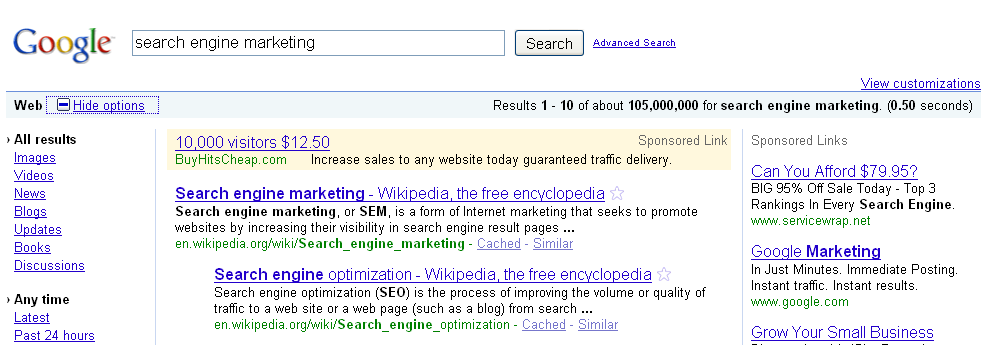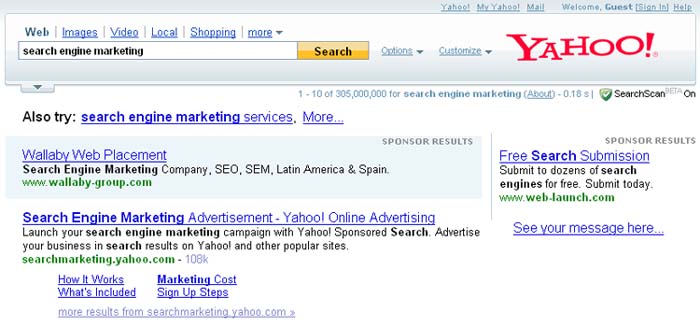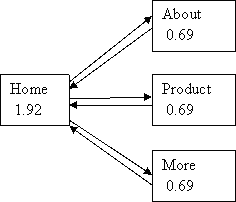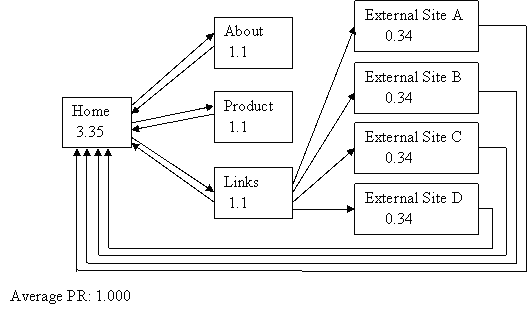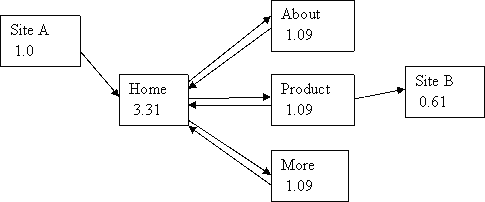Next, let’s take a look at PPC advertising which nowadays is the fastest growing marketing tool. The successful growth in this area is the result of the beneficial characteristics of PPC such as affordability and effectiveness. Actually, any site owner starting a SEO/SEM campaign will receive targeted traffic when using proper keywords directly relevant to site’s content. It is advisable to use PPC advertising in the periods before good organic rankings come about. Another added benefit of PPC is that it protects you from long organic re-indexation periods and seasonality by providing a steady stream of traffic.
As the definition states, pay per click (PPC) is an advertising technique used on websites, advertising networks and search engines.
Advertisers bid on "keywords" that they believe their target market (people they think would be interested in their offer) would type in the search bar when they are looking for their type of product or service. For example, if an advertiser sells tennis balls, they would bid on the keyword "tennis balls", hoping a user would type those words in the search bar, see their ad, click on it and buy. Keywords should be directly relevant to site content as it is easy to lose money with improper choices.
These ads are called "sponsored links" or "sponsored ads" and appear next to and sometimes above natural or organic results on the page. The advertiser pays only when the user clicks on the ad.
Abuse of the pay per click model can result in “click fraud”. Click fraud occurs in pay per click online advertising when a person, automated script, or computer program imitates a legitimate user of a Web browser clicking on an ad, for the purpose of generating an improper charge per click. Click fraud is the subject of some controversy and increasing litigation due a situation where advertising networks are also a key beneficiary of the fraud whether intentional or not.
Use of a computer to commit this type of internet fraud is a felony in many jurisdictions, for example it is covered by Penal code 502 in California, USA, and the Computer Misuse Act 1990 in the United Kingdom. There have been arrests relating to click fraud with regard to malicious clicking in order to deplete a competitor's advertising budget.
While many companies exist in this space, Google AdWords and Yahoo! Search Marketing are the largest network operators as of 2008. MSN offers their own PPC services with their MSN adCenter. There are more PPC search engines available such as Ask.com, Kanoodle, LookSmart, Miva, etc.
Depending on the search engine, minimum prices per click start at $0.01 (up to $0.50). Very popular search terms can cost much more on popular engines.
Before starting PPC campaigns, make sure the following is done:
Another PPC advertising provider you might be interested in is LookSmart with its Silver, Gold and Platinum levels of service (http://adcenter.looksmart.com). LookSmart has a built-in Conversion Tracking system that will help you measure your cost-per acquisition (CPA), the total amount you spend for each conversion. LookSmart results feed CNET's Search.com, Ask, ABCsearch, Bravenet Media, Copernic , Wikia, Enhance, Kontera and Search.com.
Experienced Search Engine marketers are playing with bids and keywords by starting from small sums and gradually growing successful keywords. This technique is depicted in more detail in our next lessons. In general dollars spent on targeted keywords for your site should have a chance for success. Any good marketing Internet based business relies on fast feedback loops to help it improve. At the beginning you want to overspend on your ads so that you can see which ones are effective. After a while regroup your ads by cost and then slash your bid price down. Ineffective ad groups or keywords will automatically shut off and just your effective ads will keep displaying.
To sum up pay-per-click is a better advertising medium for small SEM businesses because with proper keyword selection it can be affordable for any site owner. That’s why if you are starting a new site marketing strategy the first advertising option to consider should be PPC search engine promotion. After this, the best course of action would be to assess the mix of organic and paid search engine traffic as a whole, and to implement a wide-ranging search engine marketing strategy.
As the definition states, pay per click (PPC) is an advertising technique used on websites, advertising networks and search engines.
Advertisers bid on "keywords" that they believe their target market (people they think would be interested in their offer) would type in the search bar when they are looking for their type of product or service. For example, if an advertiser sells tennis balls, they would bid on the keyword "tennis balls", hoping a user would type those words in the search bar, see their ad, click on it and buy. Keywords should be directly relevant to site content as it is easy to lose money with improper choices.
These ads are called "sponsored links" or "sponsored ads" and appear next to and sometimes above natural or organic results on the page. The advertiser pays only when the user clicks on the ad.
Abuse of the pay per click model can result in “click fraud”. Click fraud occurs in pay per click online advertising when a person, automated script, or computer program imitates a legitimate user of a Web browser clicking on an ad, for the purpose of generating an improper charge per click. Click fraud is the subject of some controversy and increasing litigation due a situation where advertising networks are also a key beneficiary of the fraud whether intentional or not.
Use of a computer to commit this type of internet fraud is a felony in many jurisdictions, for example it is covered by Penal code 502 in California, USA, and the Computer Misuse Act 1990 in the United Kingdom. There have been arrests relating to click fraud with regard to malicious clicking in order to deplete a competitor's advertising budget.
While many companies exist in this space, Google AdWords and Yahoo! Search Marketing are the largest network operators as of 2008. MSN offers their own PPC services with their MSN adCenter. There are more PPC search engines available such as Ask.com, Kanoodle, LookSmart, Miva, etc.
Depending on the search engine, minimum prices per click start at $0.01 (up to $0.50). Very popular search terms can cost much more on popular engines.
Before starting PPC campaigns, make sure the following is done:
- Analyze your business niche and learn who your competitors are (the Web CEO Keyword Suggestion tool can definitely be of great help to achieve this);
- Pinpoint the search terms that you will use in your ad (keywords you are going to target and the negative keywords that you should omit);
- Learn how to write good ad copy which will have a high clickthrough rate;
- Work hard on the landing page you will link your ad to - make sure visitors do not navigate away from the sales area of your site;
- Think ahead about tracking solution that will help track and analyze your PPC campaigns, prevent click fraud, etc.
Another PPC advertising provider you might be interested in is LookSmart with its Silver, Gold and Platinum levels of service (http://adcenter.looksmart.com). LookSmart has a built-in Conversion Tracking system that will help you measure your cost-per acquisition (CPA), the total amount you spend for each conversion. LookSmart results feed CNET's Search.com, Ask, ABCsearch, Bravenet Media, Copernic , Wikia, Enhance, Kontera and Search.com.
Experienced Search Engine marketers are playing with bids and keywords by starting from small sums and gradually growing successful keywords. This technique is depicted in more detail in our next lessons. In general dollars spent on targeted keywords for your site should have a chance for success. Any good marketing Internet based business relies on fast feedback loops to help it improve. At the beginning you want to overspend on your ads so that you can see which ones are effective. After a while regroup your ads by cost and then slash your bid price down. Ineffective ad groups or keywords will automatically shut off and just your effective ads will keep displaying.
To sum up pay-per-click is a better advertising medium for small SEM businesses because with proper keyword selection it can be affordable for any site owner. That’s why if you are starting a new site marketing strategy the first advertising option to consider should be PPC search engine promotion. After this, the best course of action would be to assess the mix of organic and paid search engine traffic as a whole, and to implement a wide-ranging search engine marketing strategy.
What You Should Remember:
- If you use PPC your site gets instant and measurable targeted traffic;
- PPC helps to get prime exposure on Google, Yahoo! and other major search engines;
- You only pay for the clicks you receive;
- Most importantly - there's no limit to the traffic.

